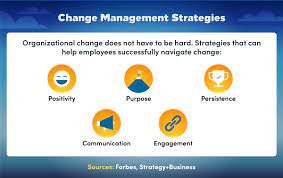Introduction
In the dynamic landscape of business, change is inevitable. Whether driven by technological advancements, shifts in market trends, or internal restructurings, businesses that can effectively manage change position themselves for long-term success. This article explores essential business strategies for navigating and leading change within organizations.
Define the Change Objectives
Before implementing any change, it’s crucial to define clear objectives. What are the specific outcomes the organization aims to achieve through the change? This clarity provides a roadmap for the change process and sets the foundation for effective communication.
Transparent Communication
Communication is paramount during times of change. Clearly articulate the reasons for the change, the anticipated benefits, and how it aligns with the organization’s overall vision. Transparency builds trust and helps employees understand the significance of the change.
Inclusive Decision-Making
Involve employees in the decision-making process regarding the change. Seek their input, address concerns, and incorporate their perspectives. When employees feel included, they are more likely to embrace and actively support the change.
Empowerment through Training
Provide training and resources to empower employees to adapt to the changes. This could involve upskilling programs, workshops, and access to tools that enhance their capabilities. Empowered employees are more resilient and better equipped to navigate change.
Encourage Innovation
Cultivate a culture that values innovation. Encourage employees to explore new ideas and approaches. A culture of innovation prepares the organization to adapt more readily to changes in the business environment.
Reward and Recognize Adaptability
Acknowledge and reward adaptability and flexibility. Recognizing employees who effectively navigate change reinforces the importance of these qualities within the organizational culture.
Detailed Roadmap
Create a comprehensive change management plan that outlines the steps, timelines, and responsibilities associated with the change. A detailed roadmap provides clarity and ensures a structured approach to implementation.
Risk Assessment and Mitigation
Conduct a thorough risk assessment to identify potential challenges and obstacles. Develop strategies to mitigate these risks, and be prepared to adjust the plan as needed based on evolving circumstances.
Visible and Supportive Leadership
Leaders play a pivotal role in managing change. Be visible, approachable, and supportive. Leaders who actively communicate, demonstrate commitment to the change, and remain accessible inspire confidence among employees.
Manage Resistance Effectively
Anticipate resistance to change and address it proactively. Engage in open dialogue, listen to concerns, and provide clear information to alleviate uncertainties. Leaders who acknowledge and manage resistance effectively contribute to the success of the change initiative.
Implement Digital Tools
Leverage technology to facilitate the change process. Implement digital tools that streamline communication, collaboration, and project management. Technology can enhance efficiency and effectiveness during periods of change.
Utilize Data for Decision-Making
Data-driven decision-making is essential during change. Use analytics and data insights to monitor progress, identify areas that require attention, and make informed adjustments to the change management plan.
Post-Implementation Assessment
After the change has been implemented, conduct a thorough assessment. Evaluate the outcomes against the defined objectives. Seek feedback from employees and stakeholders to identify areas of success and areas that may require further attention.
Continuous Improvement
Embrace a culture of continuous improvement. Learn from each change experience and apply those lessons to future initiatives. The ability to adapt and refine change strategies based on past experiences enhances the organization’s overall change management capability.
Conclusion
Effectively managing change is a fundamental skill for organizations seeking to thrive in a dynamic business environment. By establishing a clear vision, involving and empowering employees, fostering a change-ready culture, developing a comprehensive change management plan, providing strong leadership, leveraging technology, and learning from experiences, businesses can navigate change successfully and position themselves for sustained success.












